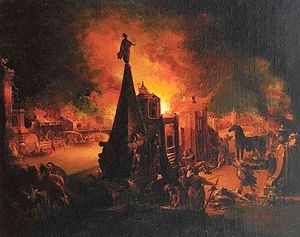Sack of Ilion
 Blick auf das brennende Troja | |
| Original Title: | Ἰλίου πέρσις |
|---|---|
| Central Theme: | |
| Synopsis: | The destruction of Troy by the Greeks (Wikipedia) |
| Series: | The Trojan Cycle |
| Preceded by: | Little Iliad |
| Followed by: | Returns |
ὅς ῥα καὶ Αἴαντος πρῶτος μάθε χωομένοιο —The Sack of Ilion[1]
|
The fifth installment in The Trojan Cycle, a lost work.
In the Sack of Ilion (Ἰλίου πέρσις) Troy finally falls to the Achaeans. This epic also seems to have been composed in the seventh century BC, supposedly by the same writer as the Aethiopis.
The Trojans are puzzled by the giant horse left parked outside the city, and the epic starts with their debate as to what they should do with it. Some want to push it off a cliff, others to burn it, while a third group believe it is an object sacred to Athena.
This third group convinces the others to bring the horse into the city, and the Trojans then celebrate the end of ten years of siege.
During this, two snakes appear and kill Laocoon (a priest of Poseidon) and his two sons. This portent causes Aeneas to leave Troy with his companions.
The Trojans celebrate into the night, and when the city is finally quiet, the Achaean Sinon signals the others with firebrands. The fleet sails back from Tenedos, the warriors inside the Trojan Horse are let loose, and the Achaeans fall upon the city.
Countless Trojans are killed and the Achaeans take hold of the city. The king of Troy, Priam, takes refuge at the altar of Zeus but is slain by Neoptolemus, while Menelaus kills Deiphobus and takes Helen back to the ships.
When Ajax tears Cassandra from the altar of Athena, he harms Athena's image. For this, the other Achaeans intend to stone him, but he escapes their judgement by also taking refuge at her altar.
In the aftermath, Odysseus kills Astyanax, Neoptolemus receives Andromache as his war prize, and the remainder of the spoils are divided up. Troy is burned and Polyxena, a daughter of Hecuba, is sacrificed at the tomb of Achilles.
Ancient fragments on the Sack of Ilion, including Proclus's summary, are available in English here.
- Continuity Snarl: Here Aeneas flees Troy after the ominous death of Laocoon, compared to his capture in the Little Iliad. Astyanax is also killed by Odysseus rather than Neoptolemus.
- Darkest Hour: This is Troy's.
- Death of the Hypotenuse: When recovering Helen, Menelaus slays Deiphobus.
- Dramatic Irony: While the Trojans debate what to do with the horse.
- Due to the Dead: It seems Achilles demanded Human Sacrifice.
- Exactly What It Says on the Tin
- Fighting for Survival: The Trojans.
- Final Battle: The culmination of ten years of war: the Achaeans are finally within the city and the Trojans are Fighting for Survival. This is the end.
- Human Sacrifice: The sacrifice of Polyxena at the tomb of Achilles.
- Infant Immortality: Completely averted.
- Kill'Em All: The confused Trojans are slaughtered.
- Last Stand
- Libation for the Dead
- Made a Slave: Numerous Trojan women, Hecuba and Andromache in particular.
- The Medic: Machaon is mentioned in a fragment, though the Little Iliad had him killed in its narrative.
- One Sided Battle: The Achaeans crept in in the dark of night, after the Trojans had celebrated their release and fallen asleep. They didn't stand a chance.
- Rape, Pillage and Burn
- Screw This, I'm Outta Here: Aeneas doesn't stay long after the death of Laocoon, and flees the city.
- Seers: Cassandra.
- Storming The City: And the Achaeans finally penetrate inside.
- Watching Troy Burn: Those who survived the attack by the Achaeans see their city looted and burned.
- Would Hurt a Child: Odysseus, who kills Astyanax.
- Euripides's
- Hecuba, a tragedy set after the fall of Troy, when Hecuba discovers her son, Polydorus's, death and that Polyxena is to be sacrificed at Achilles's tomb.
- The Trojan Women, also set after the fall, which focuses on the death of Astyanax and the allotment of captives to the Achaean warriors.
- Sophocles's
- Laocoon, a lost play about the death of the priest of Apollo.
- Ajax the Locrian, a lost play concerned with Ajax, who has dragged off Cassandra and harmed the image of Athena.
- Part of Ovid's Metamorphoses: The fall of Troy and the aftermath is detailed in part of Book XIII.
- ↑ He (Podalirius) first recognized both the raging Ajax’s / flashing eyes and burning spirit.